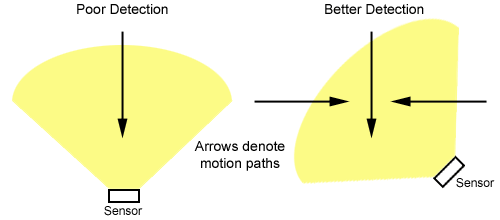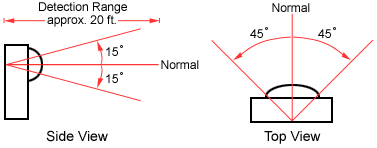Difference between revisions of "Eagle Eye Motion Sensor Setup"
X10douglas (talk | contribs) |
X10douglas (talk | contribs) |
||
| Line 1: | Line 1: | ||
==Introduction== | ==Introduction== | ||
The following instructions cover the configuration of the EagleEye (MS14A) Motion Sensor. At a minimum, a Transceiver (TM751 or RR501) or ActiveHome Pro Interface (CM15A) is required to test the EagleEye. The EagleEye is a weatherproofed version of the MS13A HawkEye II. | The following instructions cover the configuration of the EagleEye (MS14A) Motion Sensor. At a minimum, a Transceiver (TM751 or RR501) or ActiveHome Pro Interface (CM15A) is required to test the EagleEye. The EagleEye is a weatherproofed version of the MS13A HawkEye II. | ||
| + | |||
| + | *'''[[Active Eye Motion Sensor Manual en Español|Instrucciones en español]]''' | ||
==Setup== | ==Setup== | ||
Revision as of 01:05, 21 May 2014
Introduction
The following instructions cover the configuration of the EagleEye (MS14A) Motion Sensor. At a minimum, a Transceiver (TM751 or RR501) or ActiveHome Pro Interface (CM15A) is required to test the EagleEye. The EagleEye is a weatherproofed version of the MS13A HawkEye II.
Setup
When batteries are installed in the EagleEye, there is a 30 second delay before it will see any motion. After it is tripped, the EagleEye times out for 10 seconds before it can be triggered again. The default House/Unit code is A1. The default for motion detection is at all times (day and night). The default Off command delay time when no more motion is detected is 1 minute.
Testing The EagleEye
- Set the Transceiver's House code dial to A. Or, make sure the motion sensor's house code is listed in ActiveHome Pro's Transceived House Codes.
- Temporarily plug a lamp with a regular incandescent bulb into the outlet on the bottom of the Transceiver (first make sure the lamp's power switch is ON).
- lug the Transceiver into an electrical outlet.
- Press the ON/OFF button on the face of the Transceiver. You should hear the relay inside click, and the lamp will turn on or off.
- Press the ON/OFF button again to turn the unit (and the lamp) off.
- Extend the Transceiver's (or Interface's) antenna.
- Remove the EagleEye's battery cover.
- Install two AAA batteries (insert them as displayed in the diagram in the battery compartment).
- Press the HOUSE/ON button located in the battery compartment.
- The red LED light at the top of the EagleEye flashes (pulsates) to tell you it is transmitting.
- A moment later the relay in the Transceiver module should click and the lamp turn on.
- If the lamp is currently on, press the UNIT/OFF button on the EagleEye.
- The red LED light at the top flashes.
- Then the Transceiver should click and the lamp turn off.
Note: For the following four settings, you can also refer to the Motion Sensor Cheat Sheet.
Setting The House Code
- Press and hold the HOUSE/ON button (located in the battery compartment).
- The red LED light flashes.
- A few seconds later, the EagleEye will report its current House code setting. 1 blink for A, 2 for B, 3 for C all the way to 16 for P.
- When you see this, release the button immediately.
- If you want to keep the current setting, take no further action. A few seconds later, the EagleEye will timeout. It indicates this to you with a longer flash.
- If you do want to change the House code, once the EagleEye reports its current setting, press the button the number of times equal to the House code you wish to set (Once for A, twice for B, thrice for C, etc.) and hold the button down on the last press. You want to determine which code you are using before you begin programming, because the EagleEye will only wait a few seconds for you to begin entering the new code.
- A few seconds later, the red LED light will flash its new setting (1 for House Code A, 2 for B, etc.).
- If the programming fails, the red LED light will show one long flash. This can occur if you wait too long to begin, if you press the button more than 16 times, or if you press the UNIT/OFF button. If the programming procedure fails, you can start it over.
Setting The Unit Code
- Press and hold the UNIT/OFF button (located in the battery compartment).
- The red LED light flashes.
- A few seconds later, the EagleEye tells you its current House code setting. The total number of flashes equals the unit number.
- When the EagleEye starts to report its current setting, release the button.
- If you want to keep the current setting, take no further action. A few seconds later, the EagleEye will timeout. It indicates this to you with a longer flash.
- If you do want to change the unit code, once the EagleEye reports its current setting, press the button the number of times equal to the Unit code you wish to set and hold the button down on the last press. You want to decide on the code to use before you start programming, because the EagleEye will only wait a few seconds after it reports its current setting for you to begin entering the new code.
- A few seconds later, the red LED light will flash the new setting.
- If the programming fails, the red LED light will display one long flash. This can occur if you wait too long to begin programming, you press the button more than 16 times, or you press the HOUSE/ON button. If the programming procedure fails, you can start it over.
Setting The Motion Detection Mode
This configures the EagleEye to detect motion at all times or only at night. The default setting is to detect motion at all times.
- Press the UNIT/OFF button once.
- The red LED light flashes.
- Press and hold the HOUSE/ON button.
- The green LED light (located behind the sensor window) turns on.
- A few seconds later, the EagleEye tells you its current setting. Release the button. One flash represents motion detection at all times. Two flashes represent motion detection only at night.
- If you would like to keep the current setting, take no further action at this point. A few seconds later, the EagleEye will timeout. It does this with one long flash.
- If you do want to change it, press the HOUSE/ON button once to detect motion at all times and twice to detect motion only at night. Hold the button down on the last press.
- A few seconds later, the red LED light will flash again and show you the new setting.
- If this programming sequence fails, the red LED will show one long flash, and the motion sensor will time out. This can occur if you wait too long to begin, if you press the button more than twice, or if you press the UNIT/OFF button. If the programming procedure fails, you can just start it over again.
Setting The No Motion Delay
After a motion event, the sensor sends an off command when no motion is detected. The default amount of time that will pass before the OFF command is transmitted is 1 minute. The following procedure allows you to change this setting.
- Press the HOUSE/ON button once.
- The red LED light flashes.
- Press and hold the UNIT/OFF button.
- The green LED light (located behind the sensor window) turns on.
- A few seconds later, the EagleEye shows you its current setting. Release the button immediately.
The total number of flashes represent the following delay times:
| Blinks | Minutes |
| 1 | 1 |
| 2 | 2 |
| 3 | 4 |
| 4 | 8 |
| 5 | 16 |
| 6 | 32 |
| 7 | 64 |
| 8 | 128 |
| 9 | 256 |
- If you want to keep the current setting, take no further action. A few seconds later, the EagleEye will timeout. It indicates this to you with a longer flash.
- To change it, first select the correct delay time from the chart above and remember how many flashes it is (i.e. for 64 minutes there are 7 flashes). Have this all decided before trying to program, because the sensor will timeout quickly if no changes are made.
- After the sensor shows you its setting, release the button immediately, and press and release the UNIT/OFF button the correct number of times for the off delay. Hold the button down on the last press (i.e. for a setting of 64 minutes, press the UNIT/OFF button 7 times and hold on the last press).
- A few seconds later, the red LED light will flash the new setting.
- If the programming fails, the red LED will display one long flash. This can occur if you wait too long to begin, if you press the button more than 9 times, or if you press the HOUSE/ON button. If the programming procedure fails, you can start over.
Behind The Scenes
Motion Detection
The EagleEye "sees motion" using passive infrared (PIR) detection. "Passive infrared detection" is basically the detection of a change in temperature, often from body heat. If someone walks into an area protected by a sensor with Passive Infrared (PIR) Detection, then their body heat is detected, and the sensor is triggered. When the temperature is returned to its normal level, the motion sensor resets.
Sensor Detection vs. Motion Direction For best results, mount the EagleEye so the person entering the area cuts across its field of view. Do not mount the EagleEye near heating or cooling sources (heat vents, air conditioners, direct or reflected sunlight) as this may falsely trigger it.
Sensor's fields of view and detection range
Dawn/Dusk Detection
When its photo cell detects the change from light to dark, the EagleEye motion sensor sends an On command to the unit code one higher than itself; when it detects the change from dark to light, it sends an Off command. For example, you have a motion sensor controlling a kitchen light. They are both set to A1. At dusk, this motion sensor turns on a night light set to A2, which it then turns Off command at dawn. This is perfect for porch lights and night lights. The lamp that will be controlled by this feature should not be located near the EagleEye. If the lamp is too close, the light generated will cause the EagleEye to "think" it is dawn; therefore, it will send the OFF command. The light turns off, and the light level in the room drops. The EagleEye will then "think" it is dusk and send the ON command. The cycle repeats.
Related Articles
Comparison of All Motion Sensors

